Phone: (585) 902 2822
Email: info@jimmysuits.com
Tailored Elegance, Timeless Confidence.
Tailored Elegance, Timeless Confidence.
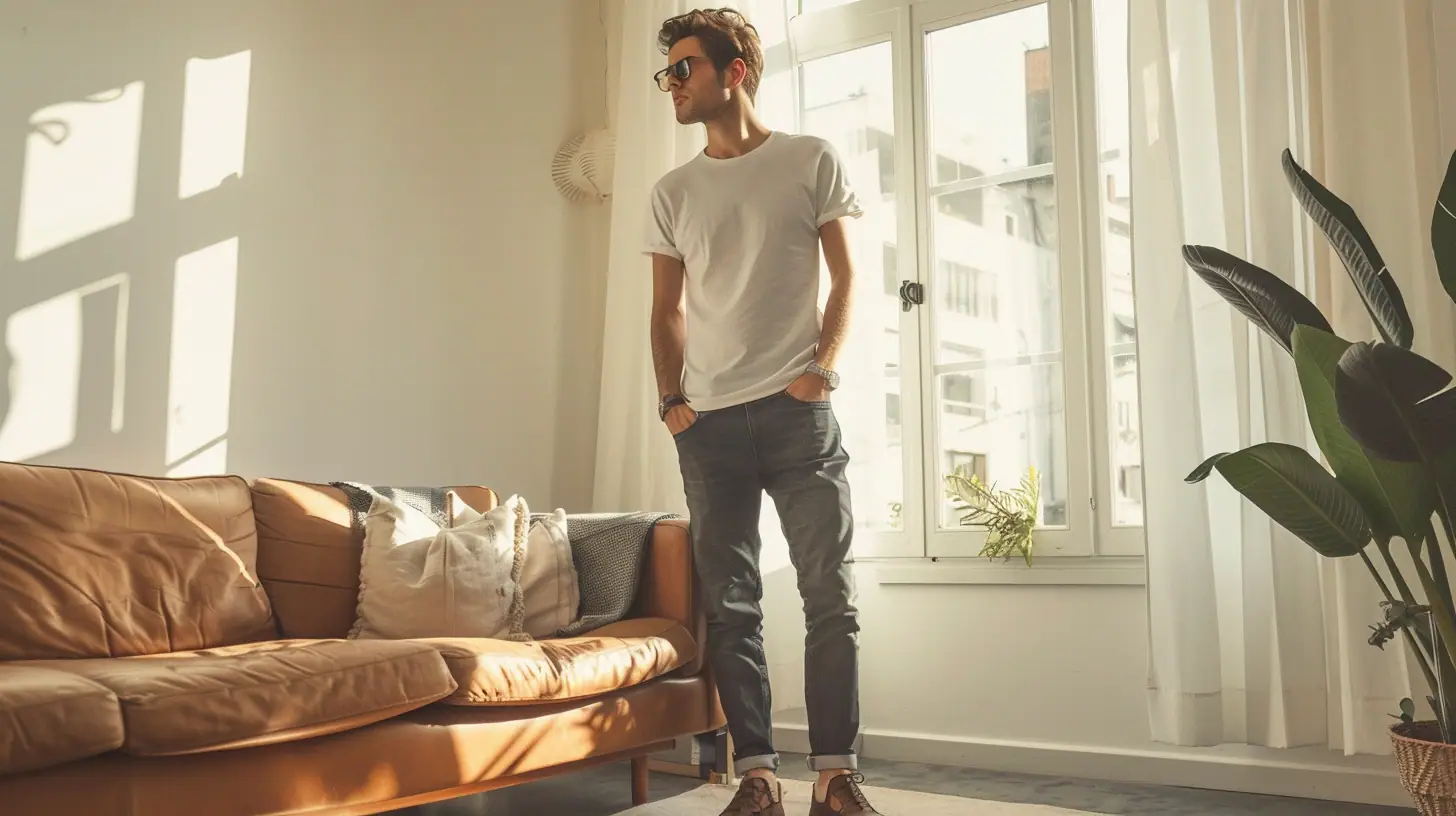
Start building your casual wardrobe with versatile essentials like well-fitted t-shirts in neutral colors, dark wash jeans, and chinos. You’ll want to focus on pieces that mix and match easily, including outerwear options like a denim jacket or bomber. Stick to a color palette of neutrals (navy, white, gray, khaki) with occasional accent colors for interest. Choose comfortable, quality footwear like white sneakers and casual boots that complement your outfits. Remember to prioritize proper fit – clothes should feel natural, not restrictive or baggy. The right combination of these elements will help you master the art of casual style.
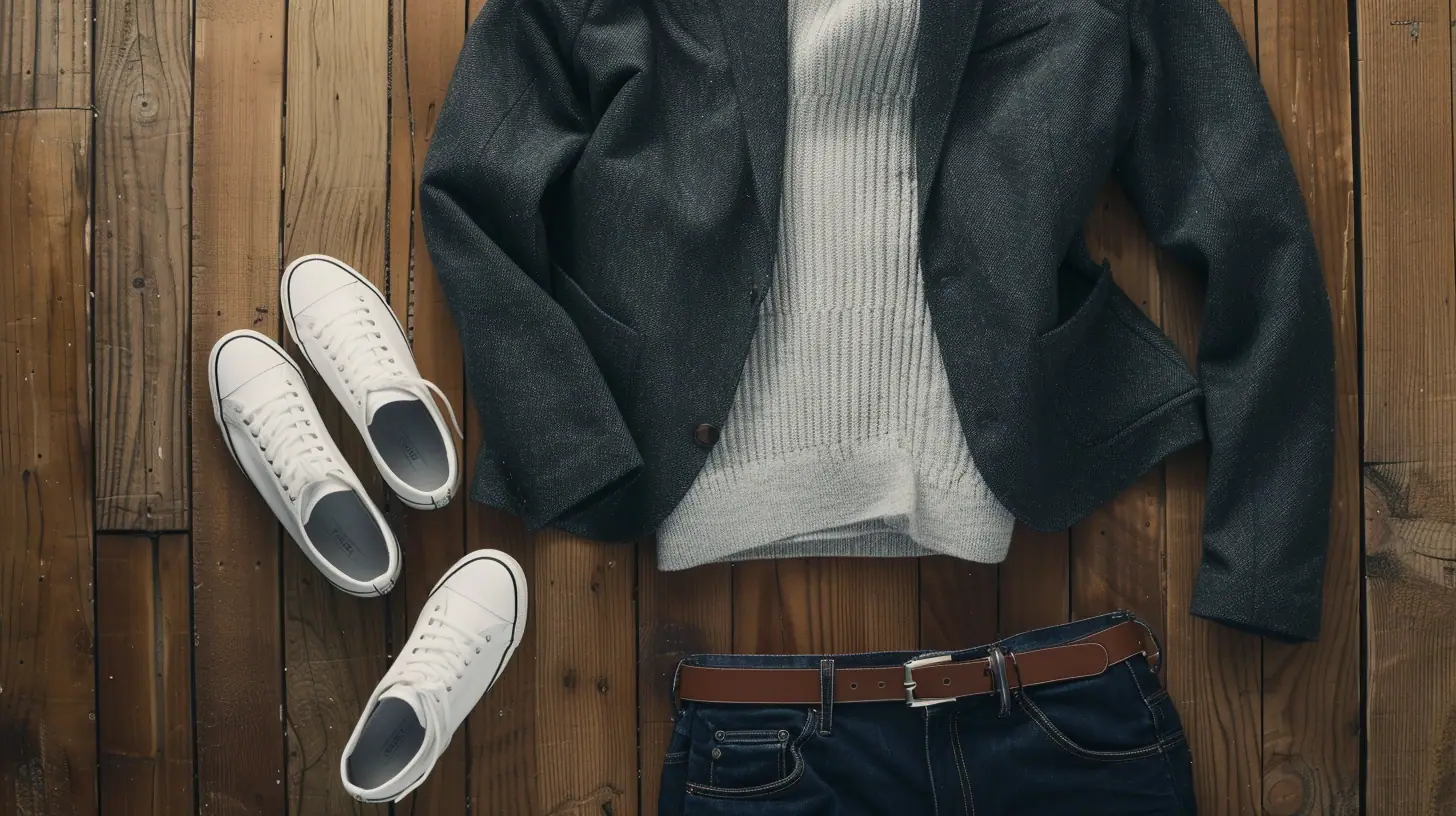
In today’s casual-focused world, building a versatile wardrobe starts with essential pieces that mix and match effortlessly. You’ll need to focus on timeless items that can create multiple outfits while maintaining comfort and style.
Start with t shirt varieties that include both crew neck and v-neck options in solid colors like white, navy, and gray. Add two to three well-fitted polo shirts and a handful of casual button-down shirts in breathable casual fabrics like cotton and linen. These tops serve as your foundation pieces for countless combinations.
For bottoms, invest in three pairs of well-fitted jeans in dark blue, medium wash, and black. Include two pairs of chinos in neutral colors like khaki and olive. During warmer months, add a pair of tailored shorts that hit just above the knee.
Your outerwear should include a denim jacket, a lightweight bomber jacket, and a casual blazer in navy or gray. These pieces help shift your looks between seasons while adding polish to simple outfits.
For footwear, start with white sneakers, brown leather casual boots, and loafers. These options cover most casual scenarios while maintaining versatility.
Complete your wardrobe with essential accessories: a leather belt, a minimalist watch, and a canvas or leather weekend bag. Remember to choose casual fabrics that are both durable and comfortable.
Your goal is to create a collection where every piece works together, allowing you to dress appropriately for most casual situations while expressing your personal style.
While having the right wardrobe staples forms your foundation, developing your personal style lets you stand out authentically. Your personal style evolution happens gradually as you discover what makes you feel confident and comfortable in your clothes.
Start by identifying what naturally draws your attention. Notice which colors, patterns, and fits you’re consistently attracted to when shopping or browsing fashion content. Pay attention to compliments you receive on specific outfits, as these often highlight your signature style elements that work well for you.
Experiment with different combinations of your basic wardrobe pieces, and document what makes you feel most like yourself. Maybe you prefer monochromatic looks, or perhaps you enjoy adding bold accessories to simple outfits. Your style might lean toward rugged workwear, sleek minimalism, or preppy classics.
Don’t feel pressured to adopt every trend or follow specific rules too strictly. Instead, incorporate elements that resonate with your lifestyle and personality. If you love wearing dark colors, make that your signature. If you feel great in fitted clothes, emphasize that in your choices.
Consider practical factors too. Your work environment, local climate, and daily activities should influence your style choices. A creative professional might have more freedom with casual wear than someone in a conservative field. Your personal style should feel natural and effortless, not forced or uncomfortable.
Remember that developing your style is an ongoing process. As you grow and change, your preferences may evolve too. Stay open to refinement while maintaining the core elements that feel authentically you.
Understanding color coordination can transform your casual outfits from basic to polished. Color psychology plays an essential role in how others perceive you and how you feel in your clothes. Start by learning which colors complement your skin tone, hair, and eyes to create a harmonious appearance that boosts your confidence.
Master these fundamental color combinations to build versatile casual outfits. Neutral colors like black, white, gray, navy, and beige work as your foundation pieces since they’re easy to mix and match. When wearing neutrals, you’ll never have to worry about clashing. For a fail-safe approach, pair darker bottoms with lighter tops, or vice versa.
To add interest to your outfits, incorporate one or two accent colors. Blue jeans work well with virtually any color top, while earth tones like olive, brown, and burgundy create sophisticated casual looks.
If you’re new to color coordination, try the 60-30-10 rule: use your main color for 60% of your outfit, a secondary color for 30%, and an accent color for 10%.
Avoid wearing more than three main colors in one outfit, as this can look chaotic. Instead, play with different shades of the same color (monochromatic dressing) for a refined appearance.
When experimenting with bold colors, remember that complementary colors (those opposite each other on the color wheel) create striking combinations, while analogous colors (those next to each other) offer subtle harmony. Start with small doses of bright colors through accessories until you’re comfortable wearing them in larger pieces.
Distinguishing between smart casual and casual dress codes often confuses many men. The key difference lies in the level of refinement and polish each style demands. Smart casual combines elements of formal wear with a relaxed approach, while casual represents everyday, comfortable attire.
Smart casual requires more attention to detail and typically includes pieces like collared shirts, chinos, dark jeans, blazers, and leather shoes. You’ll want to guarantee your clothes are well-fitted, wrinkle-free, and coordinated.
For instance, you might pair a crisp button-down shirt with tailored jeans and suede loafers for a smart casual look that’s appropriate for upscale restaurants or business meetings.
Relaxed casual, on the other hand, prioritizes comfort and functionality. This style encompasses t-shirts, hoodies, sneakers, regular-fit jeans, and other laid-back pieces. You don’t need to focus as much on precise fit or formal elements, but your clothes should still be clean and in good condition.
This look works well for weekend activities, casual gatherings, or running errands.
To determine which style to choose, consider your destination and the occasion. If you’re heading to a nice dinner or semi-formal event, opt for smart casual. If you’re meeting friends for coffee or going to the movies, relaxed casual is perfectly acceptable.
Remember that both styles can look polished – the main difference is that smart casual incorporates dressier elements while maintaining a relaxed feel.
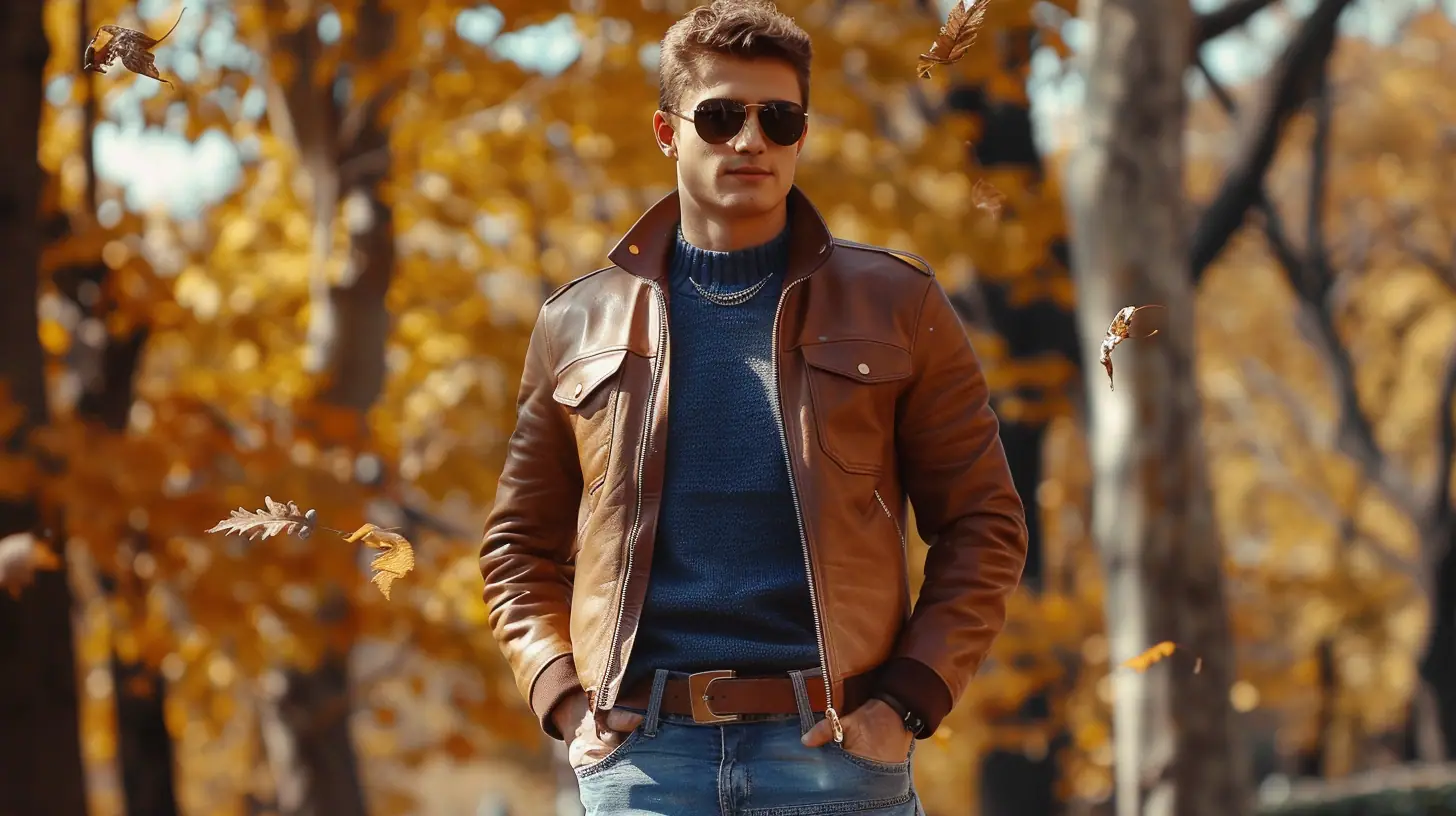
The art of dressing casually shifts dramatically with each season’s unique demands. To maintain both comfort and style throughout the year, you’ll need to adapt your wardrobe to match weather considerations while choosing appropriate seasonal fabrics. Understanding how to navigate your casual wear between seasons will help you build a versatile and practical wardrobe.
In summer, opt for breathable fabrics like linen, cotton, and lightweight blends. You’ll want loose-fitting clothes that allow air circulation while protecting your skin from the sun. Light colors reflect heat better, so incorporate whites, beiges, and pastels into your warm-weather rotation.
During spring, layer your outfits with medium-weight pieces that you can easily remove as temperatures fluctuate throughout the day.
Fall calls for warmer materials like flannel, wool blends, and medium-weight denim. You’ll find that layering becomes essential during this shifting season.
Winter demands the heaviest seasonal fabrics, including wool, cashmere, and insulated materials that trap warmth while maintaining style.
Remember to check weather forecasts when planning your outfits and always have a few versatile pieces that can adapt to sudden temperature changes. This approach guarantees you’re prepared for any seasonal situation while maintaining your casual style.
Precision in fit makes the difference between looking polished and appearing disheveled, even in casual wear. Understanding your body proportions and knowing which fit types work best for you will help you create a more refined casual appearance.
Start by measuring your chest, waist, hips, inseam, and shoulders. These measurements will guide you toward the right sizes and help you identify which brands cater to your body type. When trying on clothes, you should be able to move comfortably without restriction, while avoiding excess fabric that creates a sloppy appearance.
For shirts, verify the shoulder seams align with your natural shoulder edges. The sleeve length should hit at your wrist bone, and the body shouldn’t pull at the buttons or billow at the waist. T-shirts should skim your torso without clinging or hanging loosely.
With pants, focus on the rise (the distance from crotch to waistband) that best suits your proportions. The waistband should sit comfortably without requiring a belt to stay up. Look for pants that don’t bunch at the ankles or pull across the thighs. Common fit types include slim, straight, regular, and relaxed – each suited to different body shapes.
Remember that different brands interpret sizes differently. Don’t fixate on the size number; instead, trust how the garment fits your body. If you’re between sizes, consider whether the item will shrink with washing or if you’ll layer it with other pieces.
When in doubt, visit a tailor to adjust key pieces for a perfect fit.
Several essential casual footwear options form the backbone of a versatile men’s wardrobe. You’ll want to invest in quality shoes that combine comfort with style, guaranteeing they’re appropriate for various casual settings.
Understanding current sneaker trends while maintaining timeless appeal will help you build a collection that stays relevant. Your casual footwear collection should include both athletic footwear for active occasions and versatile slip-ons for everyday wear.
Casual loafers serve as an excellent bridge between relaxed and semi-formal situations, while different boot styles keep you prepared for changing weather conditions. For summer footwear, comfortable sandal options provide necessary breathability, and winter shoes offer warmth without sacrificing style.
When selecting your casual footwear, consider your lifestyle and typical activities. You don’t need every type of shoe, but having options for different seasons and occasions will guarantee you’re always appropriately dressed.
Remember to maintain your shoes properly to extend their lifespan and keep them looking fresh.
Moving beyond footwear choices, mastering the art of layering can transform your casual wardrobe into a versatile collection for any weather condition. Successful layering techniques start with understanding the basic three-layer principle: base layer, mid-layer, and outer layer. Each serves a specific purpose while working together to create both comfort and style.
Start with a breathable base layer that sits close to your skin, like a cotton t-shirt or lightweight henley. This foundation piece should be slim-fitting but not restrictive. For your mid-layer, opt for items that provide warmth without bulk – think cotton sweaters, lightweight fleece, or button-down shirts.
Your outer layer serves as both protection and style statement, such as a denim jacket, bomber, or casual blazer. Understanding fabric combinations is vital for effective layering. Mix textures to create visual interest: pair smooth cotton with rough denim, or sleek nylon with chunky knits.
Always make certain thinner, lighter materials stay closer to your body, while heavier fabrics work better as outer layers. You’ll want each layer to be visible, so vary the lengths slightly – let your base layer peek out beneath your mid-layer, and keep your outer layer slightly longer than both.
Remember to reflect on proportions when layering. Keep your silhouette balanced by avoiding bulky pieces in the same area. If you’re wearing a chunky sweater, balance it with slimmer pants. This approach guarantees your layered look remains polished rather than overwhelming.
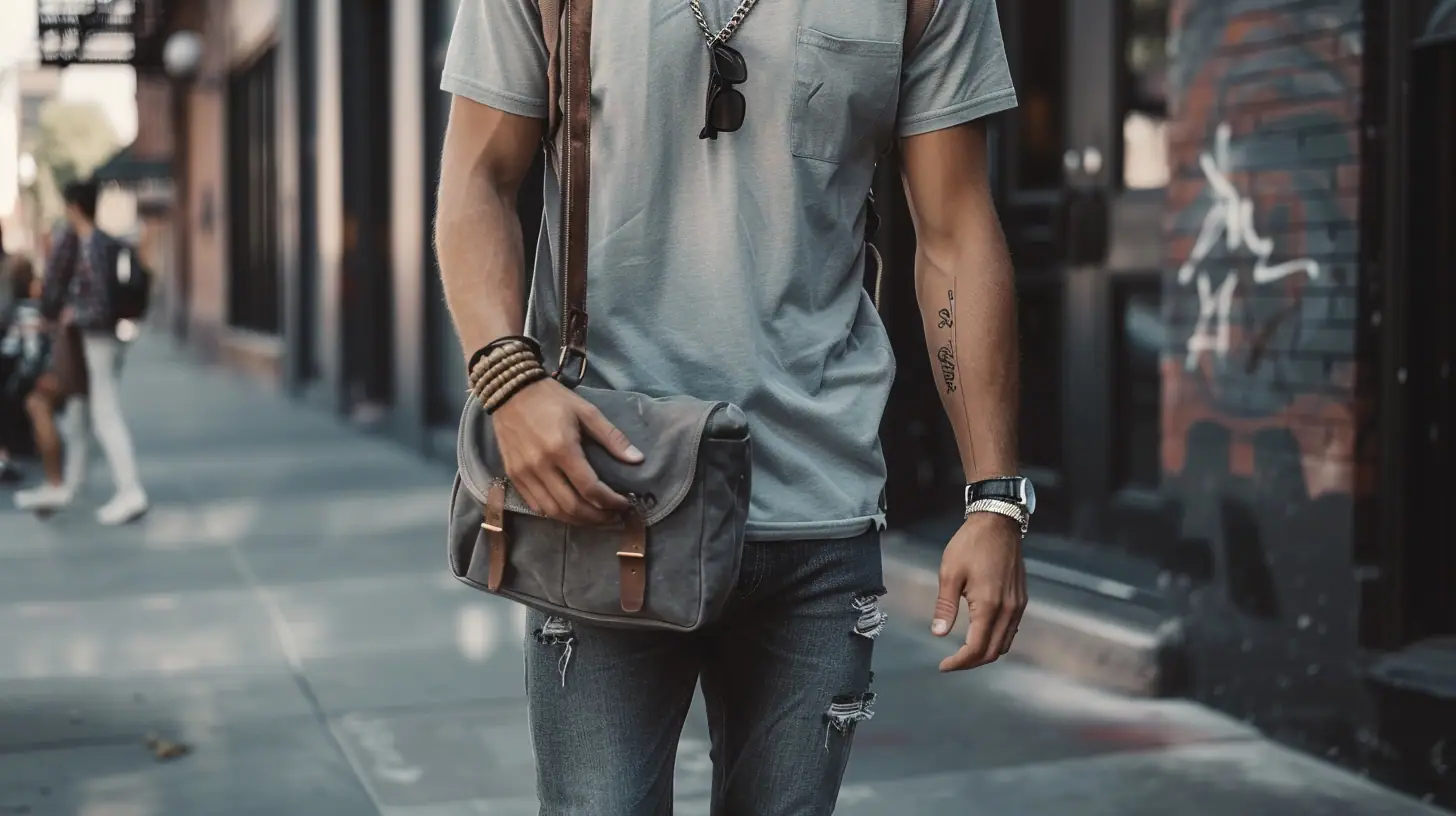
With the right accessories, even the simplest casual outfit can make a strong style statement. When selecting accessories for your casual look, it’s important to understand how they complement your layering techniques and overall style. The key is striking the perfect balance between understated and eye-catching, ensuring each accessory serves a purpose while enhancing your outfit.
Your choice of accessory types should reflect both functionality and personal style. A well-chosen watch, leather belt, or pair of sunglasses can transform a basic t-shirt and jeans combination into a more polished ensemble. Remember that casual doesn’t mean careless – each accessory should feel intentional and coordinated with your overall look.
When incorporating accessories into your casual outfits, don’t overdo it. You’ll want to maintain a relaxed vibe while still appearing put-together.
Consider your environment and activities when selecting accessories – a leather messenger bag might be perfect for work, while a canvas backpack could be more suitable for weekend adventures.
Pay attention to metals and materials, ensuring they complement each other and your clothing choices. The goal is to enhance your outfit without letting the accessories overwhelm your overall look.
Denim remains a cornerstone of casual men’s fashion, and mastering its use can elevate your entire wardrobe. Understanding denim types and how to wear them correctly can make the difference between looking polished and appearing disheveled.
Start with a well-fitting pair of dark wash jeans as your foundation. Raw or selvedge denim offers premium quality and develops unique wear patterns over time, while stretch denim provides comfort for daily wear. When selecting wash variations, remember that darker washes are more versatile and can shift from day to evening more easily than lighter ones.
Focus on fit above all else. Your jeans shouldn’t be too baggy or too tight – aim for a cut that follows your body’s natural line without restricting movement. The classic straight leg works for most body types, while slim fit suits leaner frames. The jean’s break (where it meets your shoes) should create a small fold, not pool around your ankles.
Avoid common denim mistakes like wearing overly distressed styles to semi-formal occasions or pairing similar denim washes together. Instead, when wearing double denim, create contrast by combining different washes – perhaps a light denim shirt with dark jeans.
For maximum versatility, maintain a denim collection with at least three different washes: dark, medium, and light.
Care for your denim properly by washing them sparingly in cold water, turning them inside out, and air drying to prevent fading and maintain their shape. This extends their lifespan and helps them develop natural, attractive wear patterns.
Maneuvering casual office dress codes requires balancing comfort with professionalism. While business casual offers more flexibility than traditional office attire, you’ll want to maintain a polished appearance that reflects your dedication to your work.
Today’s workplace often allows for a relaxed interpretation of professional dress, but you shouldn’t mistake casual for sloppy. Your business casual wardrobe should consist of versatile pieces that you can mix and match throughout the week. Opt for well-fitted chinos or dress pants in neutral colors, paired with crisp button-down shirts or quality polo shirts.
During cooler months, add fine-knit sweaters or sport coats to elevate your look while maintaining comfort.
Remember that office attire standards can vary considerably between industries and companies. When in doubt, it’s better to err on the dressier side of casual.
Pay attention to what successful colleagues and supervisors wear, and adjust your wardrobe accordingly. You’ll want to avoid anything too flashy or distracting, including loud patterns or excessive accessories. The goal is to look put-together and reliable while staying comfortable enough to focus on your work.
On weekends, your wardrobe should prioritize comfort without sacrificing style. Whether you’re running errands, meeting friends for brunch, or attending casual events, having versatile weekend essentials guarantees you’ll look put-together while staying comfortable.
| Essential Item | Purpose |
|---|---|
| Premium t-shirts | Foundation pieces for layering or wearing alone |
| Dark wash jeans | Versatile bottoms that work for most weekend activities |
| Canvas sneakers | Comfortable footwear that pairs with multiple outfits |
Your weekend wardrobe should include high-quality basics that you can mix and match effortlessly. Start with well-fitted t-shirts in neutral colors like white, gray, and navy. Add a couple of casual button-down shirts for slightly dressier occasions. For bottoms, invest in both dark wash jeans and chino shorts, depending on the weather and activity.
When it comes to footwear, maintain a balance between style and comfort. Clean, minimalist sneakers work well for most weekend activities, while boat shoes or loafers can elevate your look for casual events. Don’t forget to include a lightweight jacket or hoodie for layering options.
Keep your weekend accessories simple and functional. A leather watch, sunglasses, and a canvas or leather weekend bag are all you need. Remember that weekend style is about looking effortlessly put-together while maintaining the flexibility to shift between different casual activities throughout your day.
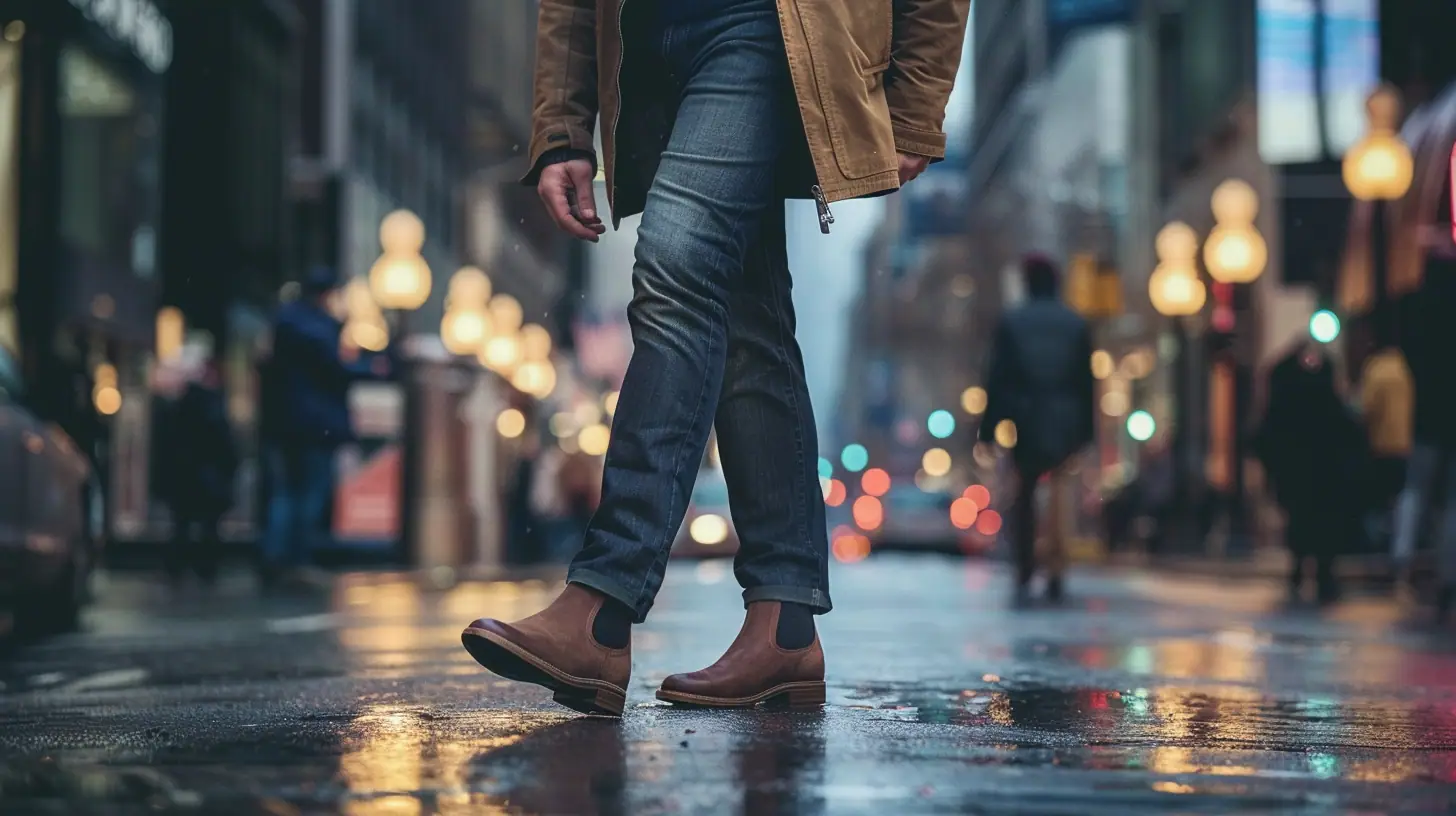
Creating the perfect casual date night outfit strikes a delicate balance between looking polished and appearing effortlessly cool. Whether you’re heading out for a first date or meeting your long-term partner, your clothing choices can boost your outfit confidence while maintaining a relaxed vibe.
You’ll want to choose pieces that make you feel comfortable yet put-together, allowing your personality to shine through. A well-planned casual date outfit combines classic elements with modern touches. Start with a foundation of well-fitted basics and add thoughtful details that elevate the look without appearing overdressed.
The key is selecting versatile pieces that work together seamlessly while being appropriate for various date settings.
Remember to keep your outfit appropriate for your destination. A smart-casual ensemble works well for most date scenarios, from dinner at a trendy restaurant to an afternoon at a local cafe.
Focus on quality materials and proper fit, as these elements will enhance your overall appearance and boost your confidence throughout the evening. Don’t forget to verify your clothes are clean, pressed, and in good condition.
Skillfully combining patterns and textures transforms a basic casual outfit into a visually dynamic ensemble. The key is understanding how different elements work together while avoiding pattern clashing that can make your outfit appear chaotic.
Start by mastering the basics: pair a bold patterned item with more subtle pieces to create visual interest without overwhelming the eye.
When mixing patterns, stick to a consistent color family and vary the scale of your prints. For example, you can pair a large-checked blazer with a small-striped shirt, keeping the colors complementary.
Don’t hesitate to combine stripes with plaids or florals with geometrics, but maintain a texture balance by mixing one bold pattern with a subtler one.
Textures add depth to your casual looks and work well with patterns. Try combining a chunky knit sweater with smooth chinos, or a sleek leather jacket with a textured wool scarf.
The contrast between rough and smooth surfaces creates visual intrigue while maintaining sophistication. Remember that denim, being a neutral texture, pairs easily with most patterns and other textures.
To build confidence in mixing patterns and textures, start with accessories. A patterned scarf or textured beanie can add interest to a simple outfit without risking pattern clashing.
As you become more comfortable, experiment with bolder combinations like a herringbone sport coat over a striped shirt, or a cable-knit sweater with a patterned button-down underneath.
The goal is to create intentional contrast while maintaining a cohesive look.
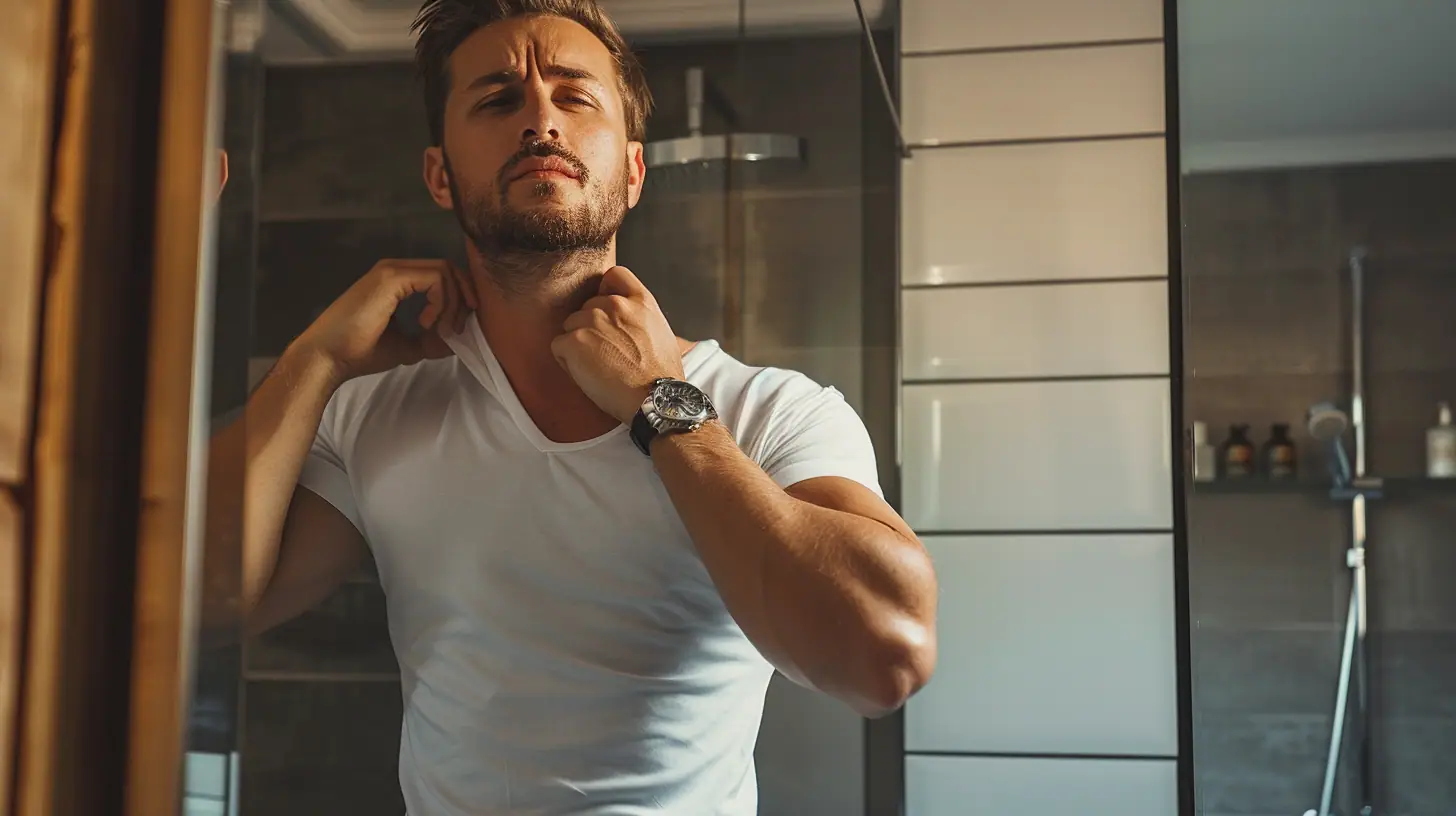
A well-dressed casual look isn’t complete without proper grooming habits to match. Your personal hygiene and grooming essentials play an essential role in how you present yourself, even in casual settings. A consistent skincare routine, well-maintained haircut styles, and thoughtful fragrance selection can elevate your casual appearance from good to great.
Beyond these basics, staying on top of personal hygiene means keeping your nails trimmed, maintaining fresh breath, and ensuring your clothes are always clean and well-maintained.
These details might seem small, but they make a significant impact on your overall casual appearance.
You can minimize the appearance of belly fat by focusing on flattering fits and stylish layering.
Choose dark-colored shirts that fall straight rather than cling, and layer them with open button-downs or light jackets.
Opt for mid-rise pants that sit comfortably at your waist, avoiding tight fits that create muffin tops.
Don’t forget vertical stripes and structured fabrics – they’ll create a slimming effect while keeping you looking casual and confident.
Like harmony in a well-orchestrated symphony, matching metals can create a polished look.
While you don’t have to match your watch to your wedding ring exactly, it’s a classic approach that’ll never go out of style.
For everyday wear, you’ll find that coordinating metals (gold with gold, silver with silver) creates a cohesive appearance.
However, mixing watch styles and metals has become increasingly acceptable, so don’t feel bound by traditional matching rules.
You can absolutely wear the same casual outfit multiple times weekly, as long as you maintain proper cleanliness and care.
Having a smart wardrobe rotation helps prevent excessive wear on individual pieces.
Focus on outfit versatility by mixing and matching different combinations of your favorite items.
Just guarantee your clothes are fresh, well-maintained, and appropriate for each occasion.
Many successful people actually prefer a simplified, repeatable wardrobe.
You can absolutely look stylish and contemporary at any age!
Focus on age-appropriate styles that combine classic pieces with modern fabric choices. You’ll look great in well-fitted dark jeans, quality cotton polos, and breathable performance materials.
Don’t feel limited by your age – just choose pieces that make you feel confident and comfortable.
Update traditional items with current cuts and colors to create a fresh, timeless look.
To maintain color preservation in your clothes, turn them inside out before washing and use cold water, which helps lock in dyes.
You’ll want to avoid overloading your washer, as clothes need room to move.
Choose gentle detergents specifically made for dark or colored items, and don’t leave wet clothes sitting in the washer.
When using your dryer, opt for lower temperatures and remove items while slightly damp.
When you’ve mastered these casual style fundamentals, you’ll move through your day like a modern-day James Dean, effortlessly cool and confidently dressed. Remember, like a well-composed symphony, your casual wardrobe should flow seamlessly from piece to piece, creating harmony in your everyday look. You’re now equipped to be your own style conductor, orchestrating outfits that strike the perfect balance between comfort and sophistication.



